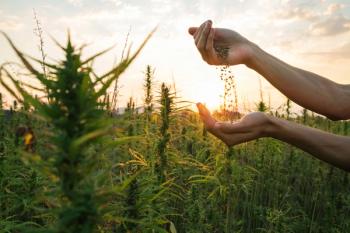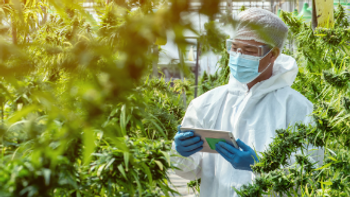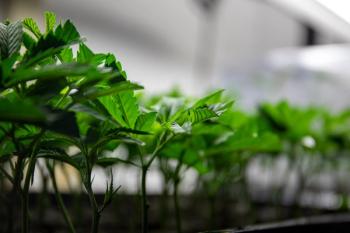
Cannabis Science and Technology
- October 2023
- Volume 6
- Issue 8
- Pages: 16-18
Heating Technologies Improve Profitability for Cannabis Greenhouses

How can greenhouse cultivators improve profitability by installing high-efficiency heating systems to reduce energy costs?
Hydronic heating systems are the most energy-efficient way to distribute heat. Equipment like low-mass boilers and low-volume aluminum finned heat pipes reduce energy consumption by heating up 83% less water and only 20% of the mass. Strategies like root zone heating bring heat distribution close to the plants to minimize energy waste. This column describes how cultivation facility operators can use greenhouse heating technologies that reduce natural gas consumption to improve profitability.
Most of the heating, ventilation, and air conditioning (HVAC) conversation around cannabis cultivation centers on cooling. But, regardless of location, cannabis cultivation facilities need some type of heat. Energy for space heating can account for less than 5% of indoor farm annual energy use, but greenhouse natural gas usage for heating end uses can account for 70–80% of annual energy usage (1,2).
Most greenhouse heating (70–80%) demand happens at night (3). Greenhouses growing cannabis have lots of ways to achieve their target environmental conditions in every season. Most greenhouses use unit heaters (steam, hot water, oil, or gas direct-fired units), a central boiler producing steam or hot water, or a combination of these systems (4). Larger greenhouses are more likely to use boilers, while smaller greenhouses more commonly utilize unit heaters. Steam heating and infrared systems are more commonly found in older greenhouses while hot water systems are more likely to be used in newer greenhouses or new construction projects (5).
Heat can be distributed via in-floor, in-bench, on-bench, under-bench, root-zone, gutter, perimeter, or top (above plant canopy) heating systems. Top heating is popular. Unit heaters represent 60% of all heating equipment dollars spent for greenhouses (3).
Unit heaters can be vented or unvented. Condensing vented unit heaters are the most energy-efficient choice, but some growers elect to use unvented unit heaters as a source of CO2 enrichment. There are some disadvantages to this strategy, as plants cannot utilize CO2 at night, which is when the unit heater is usually running, and byproducts of combustion like ethylene are detrimental to plant growth and development (6).
Greenhouses may use boilers to serve hydronic heating systems. Like unit heaters, condensing boilers offer better efficiency ratings. Low-mass boilers maximize heat transfer with lower water volumes and offer the best efficiency of any commercially available boiler technology. The newest generation of low-mass boiler equipment can also cover larger areas. Today’s technology can cover 1.5 acres with one 2,000,000-Btu boiler, when previous generations could cover only 0.5 acres with the same capacity (7).
Facilities using boilers often distribute heat using steel pipes filled with hot water. Innovations in heat pipe technology include finned heat pipes for perimeter, under-bench, and top of canopy applications. Moving heat distribution under-bench can save 20% or more in heating costs and may increase yield and plant quality (6). Since the heat is located at plant level, space temperatures can be reduced and result in persistent energy savings. Biotherm makes finned pipes out of aluminum, which transfers heat three times faster than steel (8).
Greenhouse cultivators can improve profitability by installing high-efficiency heating systems to reduce energy costs. If next steps are unclear, reach out to experts at Energy Resources Integration, LLC (ERI) for a greenhouse heating study or other energy-related services (9).
References
- Market Characterization of Indoor Agriculture (Non-Cannabis),
https://www.etcc-ca.com/reports/market-characterization-indoor-agriculture-non-cannabis . - Sanford, S., Reducing greenhouse energy consumption – An overview, Energy Efficiency in Greenhouses, 2011,
https://farm-energy.extension.org/wp-content/uploads/2019/04/2.-A3907-01.pdf . - Stone, P., and Youngsman, J., Gas-Fired Infrared Heating for Greenhouses, Roberts-Gordon, 2006,
http://www.rg-cloud.com/RG/manuals/IRGHM_Greenhouse_Manual-lo-res.pdf . - Reducing Energy Costs in California Greenhouses, University of California Cooperative Extension Service, 1985,
https://www.canr.msu.edu/floriculture/resources/energy/assets/ReducingEnergyCostsinCalifoniaGreenhouses.pdf . - Greenhouse Structures, Equipment, and Technology, Ball RedBook 19(1), Beytes, C., Ed., 2021,
https://www.ipgbook.com/ball-redbook-products-9781733254113.php . - Sanford, S., Greenhouse Unit Heaters – Types, Placement, & Efficiency, Energy Efficiency in Greenhouses, 2021,
https://farm-energy.extension.org/wp-content/uploads/2019/04/3.-A3907-02.pdf . - Zurko, J., Not Your Grandfather’s Boiler Room, BioTherm Solutions, 2021,
https://www.biothermsolutions.com/news/not-your-grandfathers-boiler-room/ . - Rearden, J., The Benefits of Finned Pipes, GrowerTalks,2022,
https://www.growertalks.com/Article/?articleid=25776 . - ERI Offers A Suite of Energy-related Services to Cannabis Cultivators, Energy Resources Integration, 2023,
https://nut.sh/ell/forms/318987/eP46om .
About the Columnist
Gretchen Schimelpfenig, PE, is a Senior Energy Engineer at Energy Resources Integration, LLC where she implements energy efficiency programs and provides direct consulting services. She is the former Technical Director of the Resource Innovation Institute and manager of the organization’s Technical Advisory Council. She authored RII’s Lighting, HVAC, and Facility Design & Construction Best Practices Guides for Controlled Environment Agriculture and the Lighting, HVAC, and Controls Best Practices Guides for Cannabis Cultivation. She has worked with partners like the University of Vermont to optimize commercial and industrial buildings, including greenhouses and controls systems used for academic research on hemp and other cultivars. She has a B.S. in Architectural Engineering from the University of Wyoming and an M.S. in Civil Engineering from Stanford University. She is a licensed Civil Professional Engineer in California and Vermont.
How to Cite this Article
Schimelpfenig, G., Heating Technologies Improve Profitability for Cannabis Greenhouses, Cannabis Science and Technology, 2023, 6(8), 16-18.
Articles in this issue
about 2 years ago
The Ongoing Myth of Potency Accuracy in Cannabis AnalysisNewsletter
Unlock the latest breakthroughs in cannabis science—subscribe now to get expert insights, research, and industry updates delivered to your inbox.



